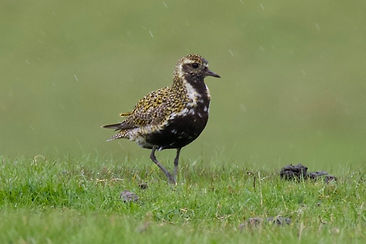Plovers
A family of largely UK resident waders. Short billed, with a run/stop/start feeding action, unlike the sandpipers. Presumably to make themselves less obvious to predators.

Golden Plover - Some breed here on moorland, especially northern Scotland. However Winter is the usual time to see them, when they congregate in often very large flocks. They can drop into pasture or wetland virtually anywhere. Despite their number and the fact that they're golden in colour it is incredible how a large flock can disappear into the landscape. The pictures showing birds on rocks were taken at Whitley Bay, Tyne and Wear. I couldn't believe my luck when a stumbled across a huge flock right by the coastal path I was walking. It would have been easy to miss them as they blended in superbly. In breeding plumage their undersides turn black.




Photo 1 shows a breeding male on Shetland in June. 2&3. Show a flock in the Autumn on the East Coast.
Grey Plover - A large, chunky plover. A few stop for the Summer but this a primarily a Winter visitor. They are a coastal species which is rarely seen inland. They develop a pure black underside in breeding plumage.


Holme Dunes, Norfolk Nov.

Keyhaven, Hants. April
Lapwing - A very distinctive, common, resident wader. A bird of wetlands and damp pasture. Very distinctive in flight with their broad shaped wings with clear black and white undersides. Much declined in number from where they were 40-50 years ago, but still an easy bird to see and always a pleasing sight.



A typical Winter scene



A newly hatched chick
Little-ringed Plover - From a distance very similar to Ringed Plover, but there are a few distinct differences. They are slightly smaller but you wouldn't pick that out in the field unless you saw them side by side. LRP's are only summer visitors. They always choose fresh water sites. Two key differences in appearance are that LRP's have a gold ring around the eye, full white headband and pinkish legs, as opposed to the orange of Ringed Plovers.




Juvenile
Ringed Plover - Slightly larger than the LRP (above), the Ringed Plover is a coastal wader, only occasionally seen inland. They have orange legs and bill, as opposed to the LRP's pink legs and dark bill. A lovely little bird which you'll often see in mixed wader flocks with dunlin, sanderling and others. Fairly common and widespread. Can be seen at any time of year as they breed around our coastline.






Photo 4 shows a juvenile. 5 shows an adult sitting on the nest.